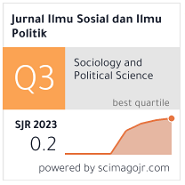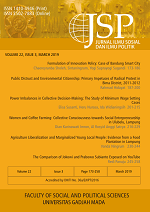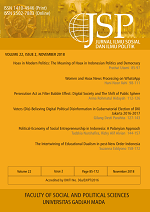Community-Care Approach for Social Work Practice: Learning from Community-Based Healthcare for Elderly in Yogyakarta
Tri Winarni Soenarto Putri(1*), Kafa Abdallah Kafaa(2), Tauchid Komara Yuda(3)
(1) Department of Social Development and Welfare, Universitas Gadjah Mada
(2) Department of Social Development and Welfare, Universitas Gadjah Mada
(3) Department of Social Development and Welfare, Universitas Gadjah Mada
(*) Corresponding Author
Abstract
This article aims to demonstrate the application of a community-care approach in the provisioning of elderly social and health care services (hereafter, social-health care) through a case study at Elderly Family Development (Bina Keluarga Lansia–BKL) Mugi Waras in Sumbersari Village, Sleman Regency, Special Region of Yogyakarta Province. This institution was chosen as a case study since it represents the best community-based long-term social-health care institution for the elderly in Indonesia. Based on the findings that have been analyzed, it was concluded that there has been shifting of institutional care provision in the community care regime towards more inclusion with mixed welfare features. This may have occurred because BKL was suffering from the lack of resources they have in dealing with the increased needs of the elderly and increased risk. Consequently, even though the influence of external stakeholders in this initiative appears quite strong, such a community-centered care initiative can be continually maintained and resulted in the hybridization model of a care regime. For social worker’s practitioner insight, the paradigm of program implementation in the BKL Mugi Waras can be adopted as a community-based social work practice that appears to fit developing countries, where elderly service intervention should be fine-tuned to the elderly residents’ living arrangements.
Keywords
Full Text:
PDFReferences
Abrahamson, P. (2016). East Asian welfare regime: obsolete ideal-type or diversified. Journal of Asian Public Policy, 10(1), 90-103. doi:10.1080/17516234.2016.1258524
Arifin, E. N., Braun, L. K., & Hogervorst, E. (2012). Three pillars of active aging in Indonesia. Asian Population Studies, 8(2), 207-230. doi:https://doi.org/10.1080/17441730.2012.680334
Blatter, J., & Haverland, M. (2012). Designing Case Study: Explanatory Approaches in Small-N Research. New York: Palgrave MacMillan.
Brocklehurst, J. C., & Allen, S. C. (1987). Theory on the nature of aging. In J.-P. Michael, Geriatric medicin for students (pp. 3-12). New York: Churchill Livingstone.
Census and Statistics Department. (1991). Hong Kong 1990 Census Report. Hong Kong: Government Printing Office.
Chi, I. (2012). Living Arrangement Choices of the Elderly in Hong Kong. Asia Pacific Journal of Social Work and Development, 5(1), 33-46. doi:10.1080/21650993.1995.9755687
Chi, I., & Leung, E. (2008). Health promotion for the elderly persons in Hong Kong. Journal of Health and Social Policy, 10(3), 37-51.
Croissant, A. (2004). Changing welfare regimes in East and Southeast Asia: crisis, change and challenge. Social Policy & Administration, 38(5), 504-524. doi:10.1111/ j.1467-9515.2004.00404.x
Esping-Andersen, G. (1990). The three world of welfare capitalism. Cambridge: Polity Press.
Gough, I. (2004). Welfare regime in development context: a global and regional analysis. In I. Gough, A. Wood, P. Barrientos, P. Bevan, Davis, & G. Room (Eds.), Insecurity and Welfare Regimes in Asia, Africa and Latin America (pp. 15-48). Cambridge: Cambridge University Press.
Health and Welfare Branch. (1994). Working Paper on the Working Group for the Care of Elderly. Hong Kong: Hong Kong Government.
Hong, K. (2008). Neither hybrid nor unique: a reinterpretation of the East Asian welfare regime. Asian Social Work and Policy Review, 2, 159–180. doi:10.1111/j.1753-1411.2008.00017.x
Jeon, B., & Kwon, S. (2017). Health and long- term care systems for older people in the republic of Korea: Policy challenges and lessons. Health Systems & Reform, 3(3), 214-223. doi:10.1080/23288604.2017.1345052
Jones, C. (1993). The Pacific challenge: Confucian welfare states. In C. Jones (Ed.), New perspectives on the welfare state in Europe (pp. 198–217). London: Routledge.
Kim, W., Lee, J. E., Chun, S. Y., Lee, T.-H., & Park, E.-C. (2019). Factors Related to the Institutionalization of Older Aged Individuals Using Home- and CommunityBased Care Services: Data From the South Korea Long-Term Care Insurance Program, 2008–2013. Journal of Aging & Social Policy, 1-17. doi:10.1080/08959420.2019.1589890
Lee, M. (2009). A path analysis on elder abuse by family caregivers: Applying the ABCX model. Journal of Family Violence, 24(1), 1-9. doi:10.1007/s10896-008-9192-5
Mehta, K. (2012). The Development of Services for the Elderly in Singapore: An Asian Model. Asia Pacific Journal of Social Work and Development, 7(2), 32-45. doi:10.1080/ 21650993.1997.9755763
Miles, B.,Huberman, M.,&Saldana, J. (2014). Qualitative data analysis: A method source book (Third ed.). California: SAGE Publication Inc.
Ministry of Health and Welfare. (2007). A guide for the expansion of infrastructure in Long Term Care Insurance. Seoul: Republic of Korea.
Mok, K. H., Kühner, S., & Yeates, N. (2017). Introduction–Managing Welfare Expectations and Social Change: Policy Responses in Asia. Social Policy & Administration, 51(6), 845–856. doi:10.1111/ spol.12335
Mok, K., & Hudson, J. (2014). Managing social change and social policy in greater China: Welfare regimes in transition. Social Policy and Society, 13(2), 235-238. doi:10.1017/ S1474746413000596
Papadopoulos, T., & Roumpakis, A. (2017). Family as a socio-economic actor in the political economies. Social Policy & Administration, 51(6), 857–875. doi:10.1111/ spol.12336
Pratono, H. P., & Maharani, A. (2018). Long- Term Care in Indonesia: The Role of Integrated Service Post for Elederly. Journal of Aging and Health, 1-19. doi:10.1177/0898264318794732
Priebe, J. (2017). Old-age Poverty in Indonesia: Measurement Issues and Living Arrangements. Development and Change, 48(6), 1-24. doi:10.1111/dech.12340
Priebe, J., & Howell, F. (2014). Old-Age poverty in Indonesia: Empirical Evidence and Policy Options: A role of Social Pension. Jakarta: TNP2K.
Rammohan, A., & Magnani, E. (2012). Modelling the influence of caring for the elderly on migration: estimates and evidence from Indonesia. Bulletin of Indonesian Economic Studies, 48(3), 399-420. doi:10.1080/00074 918.2012.728652
Schneider, Q., & Rohlfing, I. (2013). Combining QCA and process tracing in set-theoretic m ulti-m ethod res earc h. Sociological Methods and Research, 42(4), 559-597.
Stake, R. E. (2006). Multiple Case Study Analysis. New York: The Guilford Press.
Stieglietz, E. J. (1954). Geriatric Medicine (3rd ed.). London: JB Lippincpot Co.
Yin, K. R. (2009). Case Study Research: Design and Methods (4th ed.). California: SAGE Publications Inc.
Yu, S., Chau, C. M., & Lee, K. M. (2015). Using defamilisation typologies to study the Confucian welfare regime. Journal of International and Comparative Social Policy, 3(1), 74-93. doi:10.1080/21699763.2014.992457
Yuda, T. K. (2019a). Welfare regime and the patrimonial state in Contemporary Asia: visiting Indonesian cases. Journal of Asian Public Policy, 13(3), 351-365. doi:10.1080/17516234.2018.1462685
Yuda, T. K. (2018b). Healthcare decommodification in decentralization context: Reviewing the ideational constructions of “classless hospital policy” initiatives in Kulon Progo Regency, Indonesia. Asian Social Work and Policy Review, 13(1), 1-8. doi:10.1111/ aswp.12156
Yuda, T. K. (2019b). Re-examining the institutional layering of social policy configuration in Indonesia. Journal of Asian Public Policy, 0(0), 1-13. doi:10.1080/17516234.2019.1662164
Zhang, Y., & Jean Yeung, W. (2012). Shifting boundaries of care in Asia: an introduction. International Journal of Sociology and Social Policy, 32(11/12), 612-622. doi:10.1108/01443331211280665
Article Metrics
Refbacks
- There are currently no refbacks.
Copyright (c) 2020 Jurnal Ilmu Sosial dan Ilmu Politik

This work is licensed under a Creative Commons Attribution-NonCommercial-NoDerivatives 4.0 International License.






















